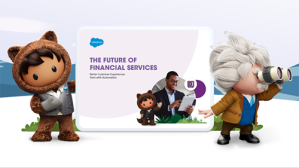Our research reveals firms must wrangle data better and track the entire customer journey to meet rising expectations. Prakash Thomas, Regional Vice President; Financial Services & Health, Salesforce Industries; ASEAN, shares four ways financial services institutions (FSIs) can drive growth through great digital experiences.
Financial services customers have a message for their providers: they like doing business online — and they aren’t going back to pre-pandemic habits.
That’s the good news from Salesforce research on financial services trends and the state of banking, insurance, and wealth management. The not-so-good news is that globally, customers are often dissatisfied with the digital experiences being offered by financial services institutions.
In the past year, digital adoption has increased in varying degrees across banking, insurance, and wealth management. It has shown steady growth during a challenging time — continuing pandemic, growing inflation, and increasing economic and geopolitical uncertainty.
Against this backdrop, digital adoption is proving to be not just resilient but unstoppable. In Asia, high rates of smartphone usage are driving growth in e-commerce and creating more opportunities for businesses to offer embedded financial services. According to a McKinsey study “Future of Asia” (Oct 2021), many financial consumers across Asia are taking this “mobile-first” approach. This leads to a rise of digital ecosystems, including highly integrated super apps that offer a one-stop-shop for a range of services.
Banks are also introducing innovations like embedded finance and banking as-a-service platforms to participate in digital ecosystems. DBS Bank in Singapore, for example, is pursuing such digital ecosystem-based opportunities. It runs marketplaces in travel, mobility, and property, and an application programming interface (API) developer platform.
So how can FSIs improve the digital experiences of their customers? To help answer that question, Salesforce conducted a survey of 2,250 customers in nine countries in April. We also interviewed six senior financial services executives in strategy, business development, and innovation to help understand how to improve service where it matters.
Based on the responses we collected in The Future of Financial Services: Better Customer Experiences Start with Automation, here are our top insights:
1. Provide experiences that are easy and transparent
The pandemic has forced financial services to focus on constantly evolving their digital experience. Both B2C and B2B financial service players needed to quickly enhance their technical capabilities to deliver more value to customers on their digital channels. The first expectation from today’s customers is, ‘I want to be able to access things digitally. I want to have a really clean website or a login page where I can access all the right features. I want a really great app.’
If you don’t have these capabilities yet, that’s a risk. Financial service institutions are losing customers to competitors because the online experience isn’t easy or intuitive. The appeal of “easy” is driving customers to digital-first financial services. In our survey, nearly half of respondents said easy and fast setup, verification, onboarding, and first-time use of the app were pushing them to try out the newer financial apps. 41% cited an easy and intuitive user interface and navigation as reasons to test out these newcomers.
Transparency is another one of the financial services trends driving customers to newcomers. More than one in three survey respondents said they switched providers — whether banking, insurance, or wealth management — because of hidden fees and fine print. Then there’s the general category of unsatisfactory experiences that prompt customers to switch providers. More than one-third of insurance policyholders left their current provider for that reason.
2. Anticipate customer needs and show you care about their financial health
Customers don’t just want products. They want to work with financial services that care about their financial health and personalise recommendations. Based on the insights from our survey participants, the industry is still falling short of customer expectations. Only 16% of banking customers, 15% of insurance customers, and 25% of wealth management consumers strongly agree that their vendors are invested in their financial wellbeing. To win customer trust and loyalty, financial services institutions should offer differentiated and value added services.
Customers want you to anticipate their needs, similar to the way product companies know what customers want next or media companies anticipate which movies customers want to watch next. Only 11% of banking, 11% of insurance, and 18% of wealth management consumers agree that companies anticipate their financial needs. Salesforce research suggests FSIs can improve their ability to do this by using predictive personalisation based on each customer’s unique journey.
According to a McKinsey 2021 personal financial survey, Asia’s share of active digital banking users increased to 88% compared to 65% four years ago. This is driving financial services to innovate to drive additional online sales. The study notes that consumer adoption of digital channels was initially strongest for transactional services. However in 2020, even high-touch products like mortgages have started to move to online channels. Overseas-Chinese Banking Corporation (OCBC) in Singapore launched a 60-minutes mortgage approval service for Singaporeans in May 2020 leveraging automation and straight-through processing of mortgages online. OCBC executed 30% of loans through this platform.
Another example is RCBC, a retail bank in the Philippines which has made significant progress in transforming customer engagement via intelligent automation. With Marketing Cloud, the bank was able to leverage customer transaction history and demographics data to establish behavioural patterns. This helped build more personalised, automated campaigns and journeys. The collective efforts of automation enabled ₱4.5 billion incremental deposits from the term deposit campaign. Delivering this successfully requires a strong tech foundation that enables end-to-end visibility of individual custom journeys.
3. Use automation behind the scenes to create great customer experiences
Creating simple automated workflows with customer data can enable delivering quick and efficient customer service. FSIs don’t need to change the entire systems or replace the whole infrastructure, according to the experts interviewed for the research. End-to-end automation can be complicated, expensive, and uncertain. Instead, they should strategically choose their specific problem spots and selectively apply automation for immediate ROI.
Wealth managers are using automation to improve onboarding and lay the groundwork for more profitable relationships. Insurers are also using automation and other technology to help significantly reduce underwriting time. Automation can have a major positive impact on B2B services, where paperwork is more complex and time-consuming than in B2C services.
4. Get creative with metrics to get a complete picture of customers
It can be especially hard for financial services institutions to create a holistic view of their customers. They don’t often have the same access to first-party data that retail businesses do. Plus, many large financial services companies are a combination of multiple smaller companies, which means customer data is scattered across different parts of the organisation.
The experts interviewed for The Future of Financial Services also recommend several ways to approach this challenge:
- Forge partnerships with external data providers who can supplement customer insights.
- Think more creatively about the types of data needed and track every step of the customer journey to identify pain points. This means going beyond tallying accounts and diving into types of accounts (whether or not they’re primary) and the ratio of low-margin and high-margin engagements.
- Invite design partners to assess the customer journey and raise the quality of interactions.
- Leverage digital distribution channels to create a platform for driving product innovations enriched by broader data sets from across the value chain.
Financial services trends point to a digital future
Learn how your financial business
can leverage automation today



This post was localised based on the original at the A.U. Salesforce blog.

























